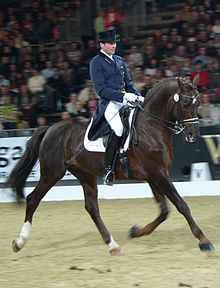Fox (horse)

The fox is a horse with brownish, reddish or yellowish fur and usually the same color, sometimes lighter, long hair.
etymology
The name fox for brownish horses - which in Europe usually stands for the red fox ( Vulpes vulpes ) - has its origin in the Middle High German name vuhs for the male red fox. The following related words are synonymous with this: Old High German fuhs , Dutch vos and English fox . The feminine form of the word changed from Old High German voha to Middle High German vohe , Gothic faúho and Old Icelandic foa . The word Fah , which stands for female red foxes in particular and for female dogs in general, is derived from this female form.
Foxes with long hair of the same color
The fox has brownish, reddish or yellowish fur and usually the same color, but also lighter, long hair. The hooves are dark, the eyes dark to light brown.
The fox comes in many different shades: light fox, copper fox, red fox, dark chestnut, cabbage fox and fox. A distinction is made according to the lightness or darkness of the fur.
genetics
A mutation in the MC1R gene (extension locus) is responsible for the fox color. The color is inherited recessively, i.e. a horse only becomes a fox if it has the mutated gene on both alleles.
In addition, the fox gene is epistatic over the agouti locus, which decides whether a horse is black or bay . This means that a horse with two fox genes is always a fox, regardless of whether it would be black or bay without this gene.
However, the brightness of the fox color is influenced by the underlying gene for brown or black color. There are a total of four different gene variants on the agouti locus. The brown with the wild type brown gene has the least black, then comes the normal brown, then the black-brown and finally the black. Correspondingly, the fox color from the fox with the wild-type brown gene to the one with the black gene is getting darker.
The relationship between fox color and the underlying brown or black color is something like this:
The extension locus is on the same chromosome as cKit , whose mutations are responsible for dominant white color , prickly hair , Tobiano and Sabino checks in horses . Therefore the predisposition for fox color is often inherited coupled with one of these predispositions.
Further influences on the fox color
Foxes with lighter long hair: light fox

Light foxes , i.e. foxes with lighter long hair, get this color from the flax gene. Dark isabelles and browns with the wind color gene can look similar .
Darker foxes
The gene smutty (also sooty) can darken the fox color even further, so that foxes can emerge that look almost like black horses.
Possible confusion
Horses that aren't genetically foxes but can look like this are:
See also
Web links
swell
- ^ Günther Drosdowski, Paul Grebe and others: Duden. Etymology. Dictionary of origin of the German language. Bibliographical Institute, Mannheim / Vienna / Zurich, Dudenverlag 1963, ISBN 3-411-00907-1 .
- ↑ L. Marklund, MJ Moller, K. Sandberg, L. Andersson: A missense mutation in the gene for melanocyte-stimulating hormone receptor (MC1R) is associated with the chestnut coat color in horses. In: Mammalian Genome . 7, 1996, pp. 895-899. PMID 8995760
- ↑ CM Woolf, JR Swafford: Evidence for eumelanin and pheomelanin producing genotypes in the Arabian horse. In: J Hered. 79 (2), 1988 Mar-Apr, pp. 100-106. PMID 3403956
- ↑ DP Sponenberg, S. Ito, LA Eng, K. Schwink: Pigment types of various color genotypes of horses. In: Pigment Cell Res. 1 (6), 1988, pp 410-413. PMID 3237609
- ↑ Krista Siebel: Analysis of genetic variants of loci for the coat color and their relationship to the color phenotype and to quantitative performance characteristics in pigs. Inaugural dissertation . Institute for Animal Science at the Humboldt University in Berlin, 2001.
- ↑ S. Rieder, p Taourit, D. Mariat, B. Langlois, G. Guerin: Mutations in the agouti (ASIP), the extension (MC1R) and the brown (TYRP1) loci and Their association to coat color phenotypes in horses (Equus caballus). In: Mamm Genome. 12 (6), 2001 Jun, pp. 450-455. PMID 11353392
- ↑ HJ. Wagner, M. Reissmann: New polymorphism detected in the horse MC1R gene In: Animal Genetics. 31 (4), pp. 289-290 (2000). [doi: 10.1046 / j.1365-2052.2000.00655.x doi: 10.1046 / j.1365-2052.2000.00655.x ]
- ^ Glynis Scott: Horse color genetics. http://www.horse-genetics.com/horse-color-genetics.html







